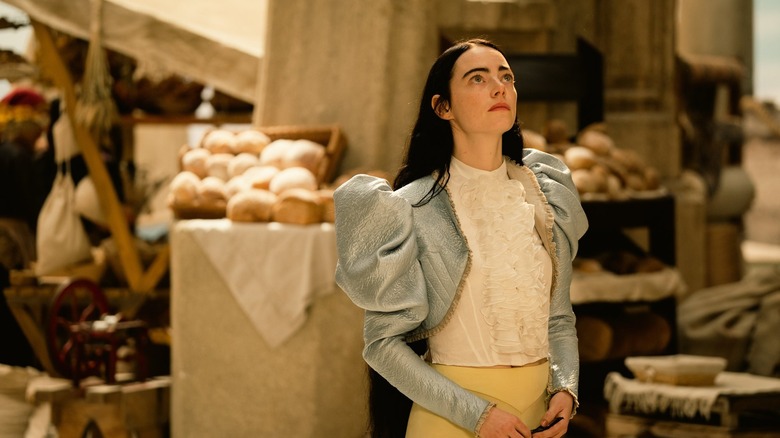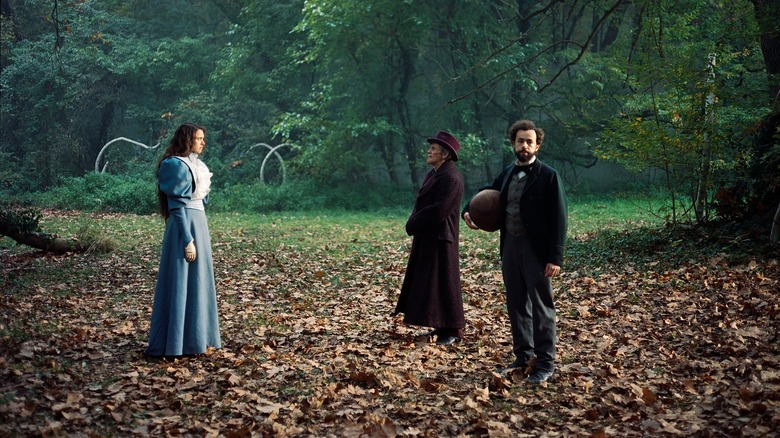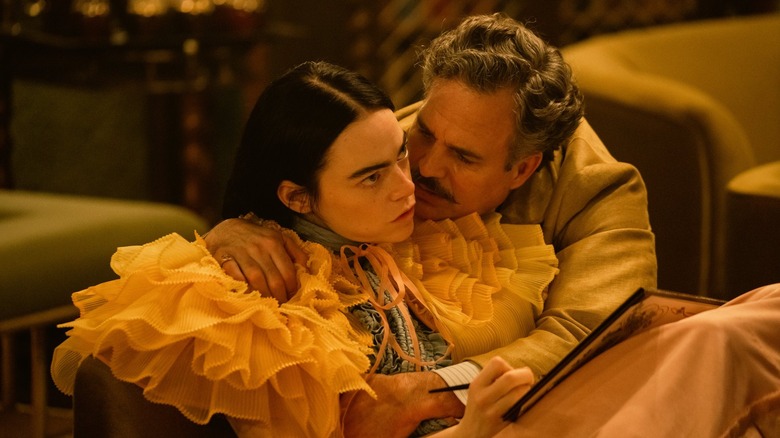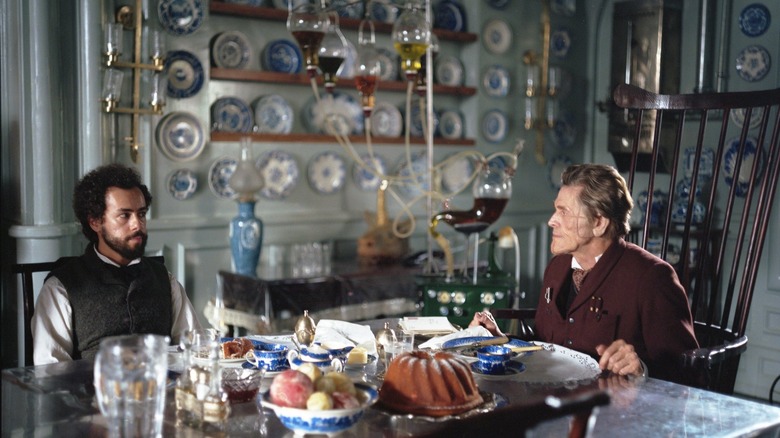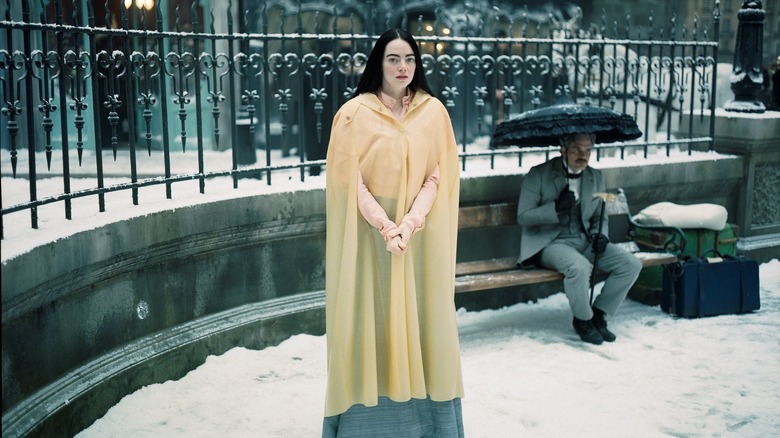The Rehearsals For Poor Things Were All About Embarrassing The Cast
Unlike the theater, movies don't typically have a long rehearsal process before shooting, but the wildly weird Yorgos Lanthimos likes to create the feeling of a theater troupe in his casts. Lanthimos is known for his unconventional style, and his process is no exception. His thespian approach helps his actors get comfortable with one another and adapt to the director's strange style in a way that they would not have time to do on a typical film set. But what exactly goes on at a rehearsal for movies like his latest triumph, "Poor Things?"
Emma Stone stars in the 2023 adaptation as a mad scientist's experiment who breaks free of men who seek to control her and also explores her newfound sexuality. The "La La Land" actor was also in Lanthimos' last film, his 2019 period drama "The Favourite." Despite Stone's reputation, she too is at "The Lobster" director's mercy during rehearsal.
The way she tells it, Lanthimos' rehearsals aren't exactly traditional scene studies where actors drill the material from the script ahead of the shoot. Instead, he focuses more on warming the cast up so that their energy can match the goofy tone of his work.
"All you do in a rehearsal with Yorgos is, like, mess around," Stone revealed to Bradley Cooper in a recent Actors on Actors talk with Variety. "You play theater games, it's not literal at all. You're not, like, reading the scenes and working out how they go. It's very playful. You're, like, a human noodle, or you're doing log rolls, or whatever. All really fun things where you kind of embarrass yourself."
Unconventional rehearsals helped build camaraderie among the cast
Yorgos Lanthimos might subject his actors to some embarrassing exercises, but he doesn't make them do it alone. Emma Stone says that the director sometimes joins in on the exercises and other times "laughs through the whole thing."
Robbie Ryan, the cinematographer for "The Favourite" and "Poor Things," would occasionally come by rehearsals to meet the cast and establish a rapport. Between the cast and the main crew, Lanthimos wanted everyone to feel "silly" and "like a troupe with each other."
The "Cruella" star said that the "Poor Things" cast felt like a seasoned theater company before the shoot even began. This helped the cast feel comfortable exploring new things with one another during the shoot.
"You're like — we've already had dinner every night," she continued, "we've already been all over each other in rehearsals, and, you know, have made fun of each other and been embarrassed, so there's nothing that really feels like it's off limits when you're on set because you're with your friends."
Lanthimos knows that his pre-production methods are unconventional in cinema. While most productions try to spend as little time as possible on the project to save money, he knows the value of a lengthy rehearsal process.
"I think I do things that are more common in theater," he admitted in a 2018 interview with The Guardian. In Lanthimos' improv games, the actors "get entangled, and they have to figure out how to get untangled, and while they're doing that, they might be doing their lines, so the lines get distorted." The director uses these exercises "to infuse the scenes and actors with an unpredictability that I find is there in real life, but isn't there when you sit down and intellectualize a scene or a role".
Emma Stone isn't the only actor who loved rehearsing with Lanthimos
"Poor Things" wasn't the only Yorgos Lanthimos film preceded by rehearsals. He also had actors rehearse for "The Favourite," which starred Academy Award-winning actor Olivia Colman, who loved getting the chance to stretch her thespian muscles.
"I love rehearsal for theater; that's probably more fun than doing the play ... even then there's still a chunk of time when people have to talk about stuff in a really irritatingly intellectual way," she explained in a 2019 interview with Deadline. "Rehearsal for screen stuff I've never liked before because it's sitting down and talking, which I don't really like doing. ["The Favourite"] was really good fun because it was basically theater rehearsals."
Colman was having a lot of fun, but she didn't see the method to Lanthimos' madness — at first. After weeks of reciting lines while doing log rolls and walking backward, she and the rest of the cast realized that, without trying to, they had become a community.
"And it took us a while to realize, but then all six of us actors doing the rehearsals said, 'Oh, right, this means there's no embarrassment, there are no inhibitions,” she continued. "We know each other so well by the time we start filming. It was joyous, and you end up knowing the whole film chronologically in the back of your head or psyche without having to really think about it."
"The Killing of a Sacred Deer" director admits his process takes influence from other areas of entertainment. Lanthimos spent "a lot of years watching and appreciating dance and theater and all of those kind of things," he told Indiewire in 2018, "and it has informed the way that I work with actors and the way I approach things."
Not every Yorgos Lanthimos film allowed for a long rehearsal process
Yorgos Lanthimos had a budget of $35 million for "Poor Things," his biggest budget to date. The larger budget afforded the director a lengthy rehearsal process where the cast was able to get to know each other and get "comfortable with ridiculing ourselves," as the director put it in a recent interview with The New York Times.
However, not all of the Greek director's films allowed for this kind of pre-production time. His 2015 film "The Lobster," starring Colin Farrell, had a budget of only $4 million. But did the film suffer as a result? Lanthimos doesn't think so.
"Because of budget constraints we didn't have the luxury of lengthy rehearsals," he explained to Bright Lights Film in 2016. "I used a couple of rehearsal scenes for the final outcome since I found that they worked very well. So the process was a rehearsal and after that we would start shooting. I love improvisation. Given the fact that the performances weren't beaten out of the actors in rehearsals, what resulted was quite spontaneous, and this in fact gives the final outcome a bit of energy."
The cast of "The Lobster" managed to find a way through Lanthimos' dystopian universe of off-beat dialogue despite not being afforded a long rehearsal process. It was his first English-language film and his breakthrough in American audiences outside the international festival circuit.
Do strange theater games really make a film better?
Beyond helping the cast get comfortable with one another and developing innate memorization of the lines, Yorgos Lanthimos' theatrical exercises also help them break out of their shells physically. They help the actors abandon any "preconceived notion" of "how people should carry themselves," which supplements the uncanny eccentricity of the director's work, he told Deadline in 2019. This was a particularly helpful exercise when it came to traditionally stuffy period settings like "The Favourite" or "Poor Things."
Despite allotting lengthy rehearsal times before both of his last films, Lanthimos would never try to "recreate the scenes as you would do on film," he continued. Moreover, the director says he would never dream of "talking about it or analyzing and explaining" — he believes that this kind of intellectualization of the scene is unhelpful and perhaps dampens the element of spontaneity.
A thespian rehearsal process gives Lanthimos' films the feeling of a traveling theater troupe, from the heightened acting style to the free-flowing creative comfort among the cast. It might be unusual, but it certainly works for him!
